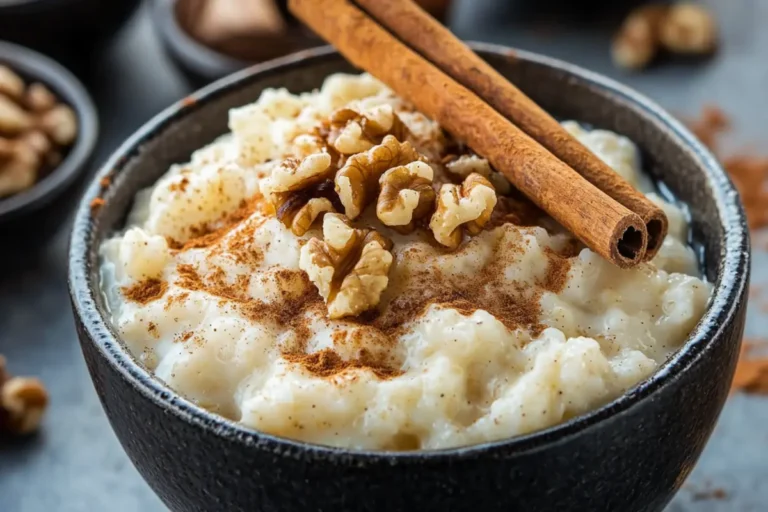Creamy Rice Pudding (Arroz con Leche)
A Delicious Traditional Dessert
Arroz con Leche (rice pudding) is a dessert loved across Spain and Latin America. With its creamy texture, sweetness, and fragrant cinnamon flavor, this dish is comfort food at its best. It’s a simple, classic dessert made with basic ingredients—rice, milk, sugar, and spices—but every country and household has its twist. Whether enjoyed warm or chilled, this rice-based treat is a satisfying dessert or snack that never fails to deliver nostalgia and warmth.
In this comprehensive guide, we’ll walk you through the traditional rice pudding recipe, explore various tasty variations, share tips to avoid common mistakes, and offer insights into its cultural significance. We’ll also delve into its nutritional benefits and answer frequently asked questions about this beloved dessert. Throughout, internal links to recipes like Chicken Parmigiana or Cottage Cheese Recipes will guide you to dishes that pair perfectly with rice pudding.
What is Rice Pudding?
This traditional rice dessert is made by simmering rice in milk, sugar, and cinnamon. While the basic ingredients stay the same, some recipes call for additions like vanilla, lemon zest, or even raisins. As a result, the dish is creamy, aromatic, and slightly sweet—perfect for ending a meal or enjoying as a snack.
Key ingredients for rice pudding include:
- Rice: Short or medium-grain white rice, which absorbs liquid well and becomes tender without losing its shape.
- Milk: Whole milk provides the best creaminess, but alternatives like almond or coconut milk can be used for dietary needs.
- Sugar: The sweetness level can be adjusted to taste, yet sugar is essential for the pudding-like consistency.
- Cinnamon and Vanilla: These spices add warmth and aromatic flavor, both essential to the dish’s traditional taste.
For a decadent dessert to serve alongside your creamy rice pudding, consider making this Ultimate Chocolate Brownie Cake, a treat perfect for chocolate lovers.
How to Make Traditional Rice Pudding
Making this dish is a simple process, though it requires patience and care to ensure the rice is cooked just right. Below is a step-by-step guide to the traditional recipe:
Ingredients:
- 1 cup white rice
- 4 cups whole milk (or plant-based milk for a dairy-free option)
- 1 cup sugar
- 1 cinnamon stick (or 1 tsp ground cinnamon)
- 1 tsp vanilla extract
- Zest of 1 lemon or orange (optional, for added freshness)
- Ground cinnamon for garnish
Instructions:
- Cook the Rice: First, rinse the rice under cold water to remove excess starch. In a medium saucepan, add the rice and enough water to cover it. Bring to a boil, then lower the heat and simmer until the water is absorbed (about 10 minutes).
- Add the Milk: Next, slowly add the milk to the saucepan. Stir constantly over medium heat to prevent the milk from sticking or burning. At this point, add the cinnamon stick and lemon zest for flavor.
- Sweeten and Simmer: After that, stir in the sugar and vanilla extract until fully dissolved. Lower the heat and continue cooking for another 20-25 minutes, stirring frequently to prevent sticking, until the rice is tender and the pudding has thickened.
- Cool and Serve: Finally, remove the cinnamon stick and lemon zest. Let the pudding cool for a few minutes before serving. Sprinkle ground cinnamon on top for garnish.
For a savory side that pairs well with this sweet dessert, consider making this Ultimate Squash Casserole, which offers a wonderful contrast of flavors.
Variations of Rice Pudding
Though the traditional recipe is always a crowd-pleaser, there are many ways to adapt the dish to suit different tastes or dietary preferences. Below are some creative variations:
1. Vegan Rice Pudding
- Swap out the whole milk for almond milk, coconut milk, or oat milk. This creates a dairy-free version of the dessert. In particular, coconut milk adds a subtle tropical flavor that pairs beautifully with cinnamon and vanilla.
2. Coconut Rice Pudding
- Alternatively, substitute half of the milk with coconut milk for a tropical twist. For extra flavor and texture, sprinkle toasted coconut flakes on top before serving.
3. Chocolate Rice Pudding
- If you’re a chocolate lover, add 1/4 cup of cocoa powder when you mix in the sugar. The result is a rich, indulgent dessert perfect for those with a sweet tooth.
4. Spiced Rice Pudding
- For a warmer, spicier flavor, consider adding a pinch of nutmeg, cardamom, or cloves along with the cinnamon. This version is especially ideal for the holiday season or cooler weather.
5. Fruity Rice Pudding
- For a refreshing twist, top your pudding with fresh berries, dried fruits, or a fruit compote. This addition brightens the dessert and offers a delightful contrast to the creamy texture.
For another unique dessert idea, check out this Coconut Macaroons Recipe, which offers a chewy, coconut-rich treat perfect for any occasion.
Cultural Significance of Rice Pudding
This traditional rice dessert holds cultural importance across Spain and Latin America. It’s more than just a dessert; it’s a dish often associated with family gatherings, holidays, and special occasions. For example, in Spain, the dish is often served with a dusting of cinnamon or with a caramelized top, similar to Crème Brûlée. Meanwhile, in Cuba, the addition of citrus zest is common, adding a fresh, zesty note to the dish.
In Mexico, rice pudding is a staple dessert during celebrations, where it’s enjoyed warm or cold. Its simplicity, combined with its comforting flavors, has made it a favorite across generations, symbolizing warmth, togetherness, and family.
Common Mistakes to Avoid
Here are some of the most common mistakes people make when cooking this creamy rice dish, along with tips to avoid them:
1. Overcooking the Rice
- Overcooking the rice can lead to a mushy texture, which can ruin the dessert. To prevent this, keep a close eye on the rice as it cooks and stir frequently to ensure even cooking.
2. Burning the Milk
- Milk can scorch quickly if cooked at too high a temperature. Thus, you should stir frequently and keep the heat at medium to low to prevent burning. If possible, use a heavy-bottomed saucepan to distribute the heat evenly.
3. Not Sweetening Enough
- Be sure to taste the pudding as it cooks to make sure it’s sweet enough. The sweetness of this rice-based treat can vary depending on personal preference, so feel free to adjust the sugar to suit your taste.
Nutritional Benefits of Rice Pudding
While rice pudding is an indulgent dessert, it also offers some nutritional benefits. When made with whole milk, it provides a good source of calcium, vitamin D, and protein. Here are some key nutritional components:
- Rice: A source of carbohydrates that provides energy.
- Milk: Rich in calcium, B vitamins, and protein for bone health and muscle repair.
- Cinnamon: Known for its antioxidant properties and its ability to help regulate blood sugar levels.
For a lighter version, you can use plant-based milk, which typically has fewer calories and less fat. You can also reduce the sugar content for a healthier, lower-sugar dessert.
FAQs About Rice Pudding
1. Can I make rice pudding ahead of time?
- Yes, this dish can be prepared in advance and stored in the refrigerator for up to 3 days. You can reheat it gently on the stovetop or in the microwave, or enjoy it cold straight from the fridge.
2. Can I use brown rice instead of white rice?
- Absolutely. Brown rice adds a nuttier flavor and offers more fiber. However, it takes longer to cook and will have a chewier texture than white rice.
3. How do I thicken rice pudding if it’s too thin?
- If your pudding is too thin, simmer it uncovered for a few extra minutes. Alternatively, you can add a small mixture of cornstarch and water to thicken it more quickly.
4. Is it better to serve rice pudding warm or cold?
- This is entirely a matter of preference. Warm rice pudding is comforting and cozy, while chilled rice pudding is refreshing, especially in warmer weather.
5. Can I freeze rice pudding?
- While it’s possible to freeze this dish, the texture may change slightly when thawed. For best results, store it in an airtight container and thaw in the refrigerator before reheating.

